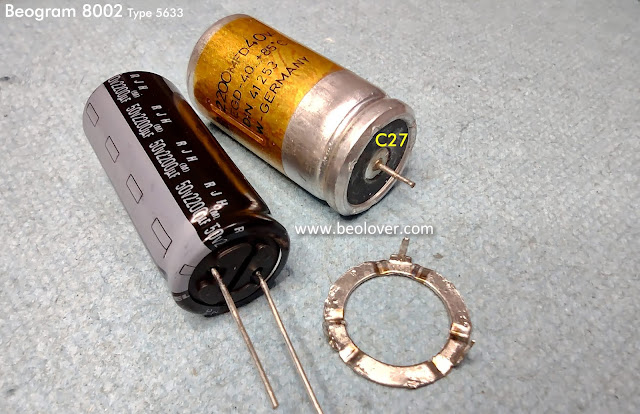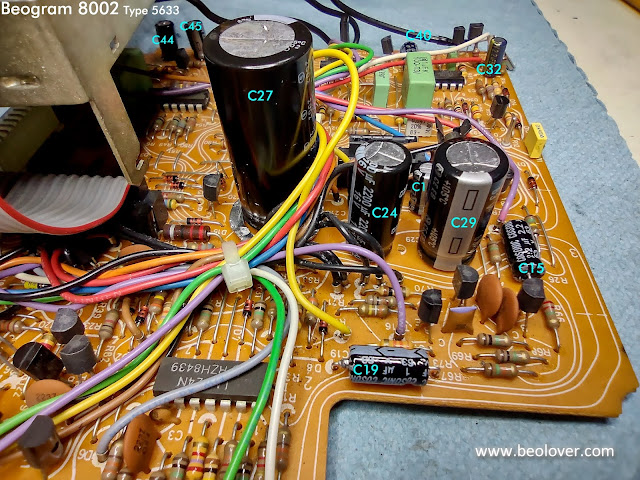This Beogram 8002 is ready to do some testing of the restored components before starting in on the service manual adjustments.
The recapping of the circuit board, transformer and chassis capacitors was completed in the previous post.
There aren't any capacitors in the button control panel but there are two LDR devices plus a lamp that will need to be adjusted during the service manual checks. On rare occasions those LDR devices and the lamp require replacement but I usually leave them alone. However, I do like to install a small test connector that is handy to use in testing the functionality of those two LDR devices.
Here is the Beogram 8002 button control panel removed and looking at the underside.
The photo shows the two adjustment screws for the LDR devices. Unfortunately there are not easily accessible test points for measuring the LDR voltages while doing the adjustment.
There is a small set screw and plastic tabs that keep the circuit board in place on the panel. You have to be careful in removing the board as I have come across quite a few panels where the plastic tabs are broken off...likely by someone that didn't know what they were doing.
I cleaned off the copper area and resoldered the wire.
The LDR adjustment calls for measuring the two LDR devices (reverse and forward) to ground so I will add a small 3-pin connector with those signals.
The test connector is a female connector so there are no exposed pins to short out when the test connector is not being used. When I make the LDR service manual adjustment I will insert a 3-pin male plug for my testing.
I also plan on measuring the various Beogram 8002 sensors with an oscilloscope so I soldered on some temporary test wires for those signals on the back of the main PCB.
That takes care of what I will need for electrical measurements while testing the Beogram.
Now I just need to reassemble the tonearm assembly in the floating chassis.
I had removed the tonearm assembly for cleaning and lubricating the Beogram.
I cleaned off all of the old lubricants and am ready to apply new lubricants to the Beogram 8002 spindle and tangential arm assembly rails.
You will notice that the rear rail is longer than the front rail and has a rubber sleeve (with a metal end cap) on each end. This type of rear rail is only on Beogram 8002 models that were built for markets where the AC line is 60 Hz. Bang & Olufsen engineers determined that the 60 Hz models were susceptible to some vibration that needed damping. This is a USA model Beogram 8002 so it has the rear rail built with the damper. Because these turntables are over 30 years old I always clean and put some rubber conditioner on the ends.
To lubricate these parts I use some Tri-Flow synthetic grease on the mounting points of the spindle followed by a mixture of Rocol MTS 2000 and ESSO NUTO HP32 (1:1 ratio) on the spindle itself. On the front and rear rails that the tonearm assembly slides on I use some Tri-Flow dry lube. I have also used white D.C. M-kote paste on the rails as I use on the Beogram 400x turntables.
While the tonearm assembly is removed from the spindle and rails there is one service manual check/adjustment to go ahead and make.
The horizontal parallelism adjustment screw is on the bottom of the tangential arm assembly. So it is not accessible when the arm assembly is installed.
This adjustment is to line up the top surfaces of the tonearm and the fixed arm so they are even with each other. Here is a photo of the adjustment screw.
Another adjustment screw that is only accessible from underneath the tonearm is the screw that holds the tracking force slider control in place. Sometimes this screw can become loose and the tracking force slider slides too easily. Often drifting away from the setting an owner sets it to.
While I have easy access to the screw I made sure it is securely in place and the slider does not move too easily (there should be a little bit of friction).
Reinstalling the rails, spindle, spindle nut and tonearm assembly requires a bit of maneuvering of the parts all at once but it isn't too difficult. The rear rail must be fit through the tonearm assembly base and through the bracket that attaches to the spindle nut. Obviously the orientation of the parts are critical as well.
Everything can now, gently be tilted over to fit properly on the floating chassis.
The tangential arm servo motor belt and the position, rotary sensor assembly can now be reinstalled.
I can now start connecting floating chassis components together to see how the restored parts work.
A couple of quick checks are needed though.
Check that the center hub of the Beogram 8002 (with the tachodisk for the platter speed detection) spins easily and does not contact any part of the sensor assembly. This one is good.
The top platter is not necessary for testing the basic Beogram 8002 functionality but the black, sub-platter is. The metal sub-platter passes between the curved slot of the two tangential drive motor components and is actually part of the motor. Without the sub-platter in place nothing will turn and the Beogram 8002 will try to drive the motor anyway ... and could blow a fuse.
Finally...here we go with the first power on test of the restored parts.
Everything that needs to be connected is connected.
Pressing play I get an operating platter, the tonearm assembly moves and the Beogram 8002 control logic is able to lock in the platter speeds.
As I expect to observe (and hear) the Beogram 8002 platter and tangential arm assembly operate extremely quiet and very smoothly.
That is it for this post.
Next time I will measure the power supply voltages and view some sensor signals on the oscilloscope.
I will also finish up the service manual adjustments for the tonearm tracking force, record tracking and the forward/reverse LDR scanning voltages.





























































